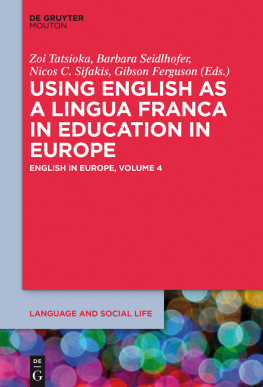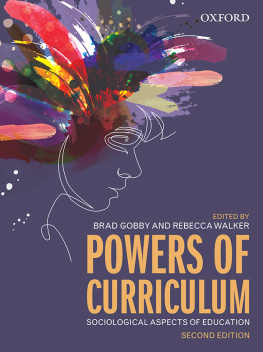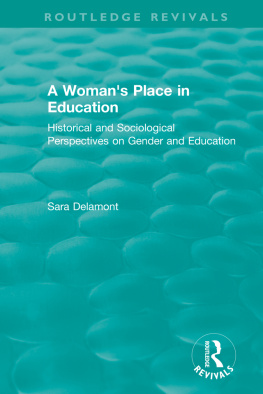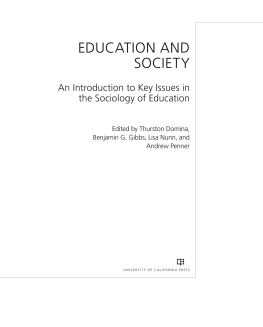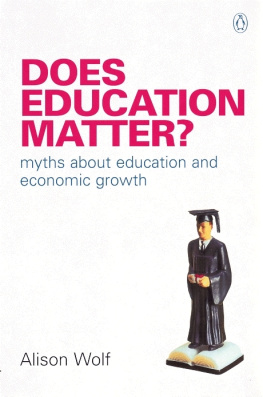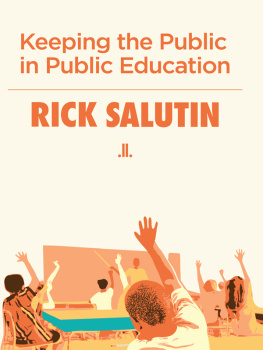The International Library of Sociology
ENGLISH PRIMARY EDUCATION
The International Library of Sociology
English Primary Education
A Sociological Description
Part I Schools
by W. A. L. Blyth
First published in 1965 by
Routledge
Reprinted 1998, 2000, 2002
by Routledge
2 Park Square, Milton Park, Abingdon, Oxon, OX14 4RN
Transferred to Digital Printing 2007
Routledge is an imprint of the Taylor & Francis Group
1965, 1967 W. A. L. Blyth
All rights reserved. No part of this book may be reprinted or reproduced or utilized in any form or by any electronic, mechanical, or other means, now known or hereafter invented, including photocopying and recording, or in any information storage or retrieval system, without permission in writing from the publishers.
The publishers have made every effort to contact authors/copyright holders of the works reprinted in The International Library of Sociology. This has not been possible in every case, however, and we would welcome correspondence from those individuals/companies we have been unable to trace.
British Library Cataloguing in Publication Data
A CIP catalogue record for this book is available from the British Library
English Primary Education - Part I: Schools
ISBN 0-415-17762-6
The Sociology of Education: 28 Volumes
ISBN 0-415-17833-9
The International Library of Sociology; 274 Volumes
ISBN 0-415-17838-X
Publisher's Note
The publisher has gone to great lengths to ensure the quality of this reprint but points out that some imperfections in the original may be apparent
To teachers in primary schools
Contents
| VOL. I: SCHOOLS |
| VOL. II: BACKGROUND |
| PREFACE |
| PREFACE TO THE 1967 REPRINT |
| INTRODUCTION |
| I. | THE MIDLANDS OF CHILDHOOD IN ENGLISH SOCIETY |
| A. SOME IDSTORICAL INFLUENCES UPON THE MIDLANDS OF ENGLISH CHILDHOOD |
| B. RECENT DEMOGRAPHIC ASPECTS OF THE MIDLANDS OF ENGLISH CIDLDHOOD |
| C. CONCLUSION: THE SIGNIFICANCE OF THE MIDLANDS OF CIDLDHOOD IN ENGLAND TODAY |
| II. | THREE TRADITIONS IN ENGLISH PRIMARY EDUCATION |
| A. THE ELEMENTARY TRADITION |
| B. THE PREPARATORY TRADITION |
| C. THE EMERGENCE OF A DEVELOPMENTAL TRADITION IN ENGLISH PRIMARY EDUCATION |
| III. | THE CHILDREN'S WORLD |
| A. THE IMMEDIATE CONTEXT |
| The Family |
| Homes as Habitats |
| Neighbourhoods as Habitats |
| Peers and Peer Culture |
| B. THE WIDER WORLD |
| General Aspects |
| The 'Mass Media' |
| Organised Activities and Informal Education |
| C. FILTRATION: A THEORY ABOUT RECEPTIVITY TOWARDS THE WIDER CULTURAL INFLUENCES |
| D. CONCLUSION |
| IV. | PRIMARY SCHOOLS AND THEIR LOCAL ENVIRONMENT |
| A. PRIMARY SCHOOLS IN VARIOUS TYPES OF ENVIRONMENT |
| Village Schools |
| Small-Town Schools |
| Schools in the Rural-Urban Fringe |
| Schools in Larger Towns and Cities |
| (a) Schools in Outer Suburbs |
| (b) Schools on Corporation Estates |
| (c) Schools in Intermediate Suburbs |
| (d) Schools in Inner Suburbs |
| B. TUB RELATIONSHIPS OF PRIMARY SCHOOLS WITH THEIR LOCAL ENVIRONMENT |
| The Utilisation of the Immediate Environment by Primary Schools |
| The Impact of Primary Schools on their Local Environments |
| Primary Schools and Planning |
| V. | PRIMARY EDUCATION AND THE GREAT SOCIETY |
| A. THE SOCIAL-CLASS ASPECT |
| D. THE RELIGIOUS ASPECT |
| C. THE POLITICAL ASPECT |
| D. THE ECONOMIC ASPECT |
| E. THE CULTURAL ASPECT |
| F. THE COMPARATIVE ASPECT |
| REFERENCES |
| BIBLIOGRAPHY |
| SUPPLEMENTARY BIBLIOGRAPHY |
| INDEX to both volumes |
Tables
IN 1963 the Central Advisory Council for Education (England), under the chairmanship of Lady Plowden, was required 'to consider primary education in all its aspects and the transition to secondary education'. Thus, for the first time since the publication of the two reports of the Consultative Committee of the Board of Education on The Primary School (1931) and Infant and Nursery Schools (1933), primary education has been singled out for specific official scrutiny. This should stimulate the English educational world in general to 'consider' primary education more closely and to examine its various 'aspects' more carefully.
One of these aspects may be legitimately termed the sociology of primary education. Since 1945, British sociologists have paid increasing attention to education, so that the sociology of education is now an established and expanding field of study and research. Its impact has already been felt on our general habits of thinking about education, and more specifically on the Central Advisory Council's recent reports 15 to 18 (Crowther Report, 1959) and Half our Future (Newsom Report, 1963). Yet it is noticeable that most of the research, and most of the general writing, in the sociology of English education has been confined to secondary and further education, almost as though sociologists thought that life began at eleven-plus. Even Ottaway's pioneering textbook (1953) displayed this emphasis. Ironically perhaps, it was through examination of the problems of secondary education, and particularly those of selection for secondary education, that the attention of sociologists has been increasingly drawn towards primary education too.
Meanwhile, there has been a growing tendency for writers about primary education itself to pay attention to sociological factors, both those associated with the organisation of primary schools as communities, and those more directly related to the home and community background of primary-school pupils. This sociological awareness is particularly evident in books such as those by volumes have been written in the belief that there is a need for a study of this kind, and that it is required now, as an introduction to the sociological 'aspect' of primary education, while the Plowden spotlight is focused on primary schools.
The result is something of a compromise. This is perhaps inevitable, if it is to be of service to the various types of reader who may be interested in the subject: students preparing to teach in primary schools; experienced teachers who appreciate the importance of sociological considerations; teachers and others who themselves wish to pursue some further study or research; and the general public who as parents and citizens recognise the importance of primary education as a social process in English society. But because it is a compromise it concentrates neither on research, nor on a purely theoretical interpretation, nor on practical prescription and advice. Therefore it cannot be appropriately entitled an investigation, nor an analysis, nor a do-it-yourself manual for teachers, though it embodies elements of all three. It is simply a sociological description of English primary education; an account of the whole social process and its institutional framework, including much of the data familiar to the historian or the psychologist or the expert in teaching-method, but seen from the standpoint of a sociologist and presented, I hope, in such a way that its various readers may find in it something of value to them.


